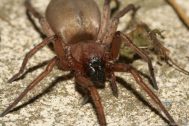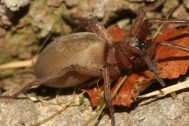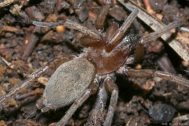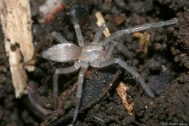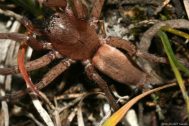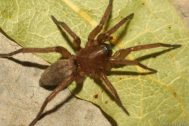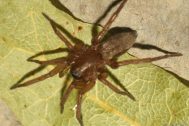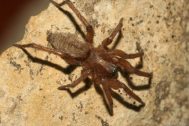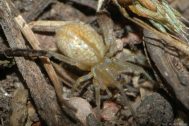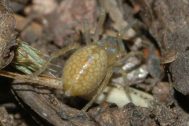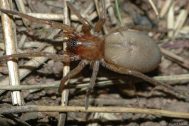| Nálezy podle období | |||||
|---|---|---|---|---|---|
| Gnaphosidae | 0-1900 | 1901-1950 | 1951-2000 | 2001+ | ∑ |
 Drassodes cupreus
(Blackwall, 1834) Téměř ohrožený Drassodes cupreus
(Blackwall, 1834) Téměř ohrožený |
1× | 1× | 72× | 80× | 154× |
 Drassodes lapidosus
(Walckenaer, 1802) Není ohrožený Drassodes lapidosus
(Walckenaer, 1802) Není ohrožený |
1× | 10× | 672× | 273× | 956× |
 Drassodes pubescens
(Thorell, 1856) Není ohrožený Drassodes pubescens
(Thorell, 1856) Není ohrožený |
3× | 10× | 437× | 161× | 611× |
Literatura
Personality predicts mode of attack in the generalist ground spider predator
Personality traits, such as boldness and/or aggressiveness, have long been accepted to have a profound influence on many aspects of the lives of animals, including foraging. However, little is known about how personality traits shape the use of a particular attack strategy. Ground spiders use either venom or silk attack to immobilize prey. In this study, we tested the hypothesis that behavioral differences among individuals (namely boldness, measured as the time spent exploring a novel environment; and aggressiveness, measured as the number of killed but not consumed prey) drive the use of a particular attack strategy. We used a generalist ground spider, Drassodes lapidosus, and recorded the mode of attack on two types of prey, dangerous and safe. Moreover, we measured the size of the venom gland to test the relationship between the size of venom volume and the personality, as well as the mode of attack. Drassodes individuals showed consistent behavioral differences in the way they attacked prey. Venom attack was significantly related to increased aggressiveness when attacking spider (dangerous) prey and to increased boldness when attacking cricket (safe) prey. Silk attack was more frequently used by shy (for cricket prey) and docile (for spider prey). The volume of venom was not related to the attack strategy. We conclude that personality traits are important drivers of prey-capture behavior in generalist ground spiders.
Překvapení z překvapení
Unusual loops of the seminal duct (sperm duct) in the species Drassodes lapidosus? Atypical seminal ducts in the species Nigma walckenaeri are also mentioned.Pavouk 50 (07/2021)
Pavouci České republiky; Západoevropský slíďák Pardosa tenuipes objeven v Česku; První nález Paratrachelas maculatus (Trachelidae) v České republice; Druhý nález snovačky Steatoda nobilis v Česku; Neobvyklý biotop nálezu snovačky Theridion hannoniae; Drassodes cupreus nebo Drassodes lapidosus nebo...?; Pavouci nehlubokých podzemních biotopů Slovenska; Lovčík vodní potvrzen na jižní Moravě; Two remarkable records of Bulgarian spiders; Předběžný seznam sekáčů (Opiliones) NP České Švýcarsko a CHKO Labské pískovce; Pojídají pavouci ovoce?; Hrabalky (Pompilidae) - specialisté na lov pavouků VIII: rod Auplopus; Milan Antuš (1936-2021); Letošní exkurze na JV Prahy za pavouky; Česká bibliografie; Britská bibliografie; Inventarizace 2020; Pokyny pro autoryInfluence of surface flattening on biodiversity of terrestrial arthropods during early stages of brown coal spoil heap restoration.
Heterogeneity of environmental conditions is the crucial factor supporting biodiversity in various habitats, including post-mining sites. The effects of micro-topographic heterogeneity on biodiversity and conservation potential of arthropod communities in post-industrial habitats had not been studied before now. At one of the largest European brown coal spoil heaps, we sampled eight groups of terrestrial arthropods with different life strategies (moths, spiders, ground beetles, ants, orthopteroids, centipedes, millipedes, and woodlice), in successionally young plots (5–18 y), with a heterogeneous wavy surface after heaping, and compared the communities with plots flattened by dozing. A combination of the standardized quantitative sampling, using two different methods, and a paired design of the plot selection enabled a robust analysis. Altogether, we recorded 380 species of the focal arthropods, 15 of them nationally threatened. We revealed the importance of the microtopographic heterogeneity for the formation of the biodiversity of arthropods in their secondary refuges. The communities with higher biodiversity and conservation value were detected in the plots with heterogeneous surfaces; exceptions were ground beetles and millipedes. The surface flattening, often the first step of technical reclamation projects, thus suppress biodiversity of most terrestrial arthropods during the restoration of post-mining sites. Since the communities of both surface types differed, the proportional presence on both surfaces could be more efficient in supporting the local biodiversity. We suggest reducing the surface dozing for the cases with other concerns only, to achieve a proportional representation of both surface types. Such a combination of different restoration approaches would, thus, efficiently support high biodiversity of groups with various needs.
Invertebrates of the Macocha Abyss (Moravian Karst, Czech Republic).
The invertebrates of the Macocha Abyss, Moravian Karst, Czech Republic, were collected in 2007–2008 and 222 species were identified in total. The relative abundance of individual taxa of land snails, harvestmen, pseudoscorpions, spiders, millipedes, centipedes, terrestrial isopods, beetles, and ants was evaluated. The cold-adapted mountain and subterranean species inhabit the bottom and lower part of the abyss, whereas the sun-exposed rocky margins were inhabited by thermophilous species. Macocha harbors several threatened species that are absent or very rare in the surrounding habitats. In the forest landscape, the Macocha Abyss represents a natural habitat with a distinct microclimatic gradient, and is an excellent refuge area for psychrophilous as well as thermophilous species, which significantly contributes to maintenance of landscape biodiversity.
Spiders on sandstone rocks in Central Europe with particular reference to the Bohemian Switzerland National Park.
While the majority of the Central European landscape would be covered by forests without human influence, rocky areas form isolated, islet-like, natural, non-forest habitats. The surface of some of these non-forested areas is composed of bare bedrock or products of its erosional breakdown (without a soil layer) such as gravel, sand banks, sand dunes, scree slopes and rock outcrop habitats. These habitats harbour specialized spider species that depend on their specific substratum and microclimate (Růžička 2000). Out of these habitats, rock walls (and scree slopes) form one of the most distinct ecological gradients of any terrestrial ecosystem (Larson et al. 1989, Růžička et al. 1995). They provide habitats with extremely warm and cold microclimatic conditions in close proximity. They also belong to habitats almost unknown until now due to the technical and practical problems of sampling.
Sandstones can form extensive systems of rocks, sometimes with a broad spectrum of meso- and microhabitats due to their very dynamic relief. Sandstone rocks are characterised by a marked contrast between forested plateau and bare vertical rock walls (Balatka and Sládek 1984). Upper margins of rocks are dry, vertical rock walls can be sun-exposed, dry and bare, or shady and humid and hence covered by mosses. Spaces with an extremely cold climate can occur in deep gorges. The aim of this study is to evaluate available data on the species composition of spider assemblages in sandstone rocks, including new data about spiders on rock walls in the Bohemian Switzerland (České Švýcarsko) National Park.
Fotografie
Drassodes cupreus
Drassodes lapidosus
Drassodes pubescens
Statistiky
Dle měsíce v roce
Dle nadmořské výšky
Dle metody sběru (1720 použitých nálezů)
| Zemní past | Samci | Samice | Mláďata | Nálezy |
|---|---|---|---|---|
| Drassodes cupreus (Blackwall, 1834) | 168 | 71 | 0 | 107 |
| Drassodes lapidosus (Walckenaer, 1802) | 1185 | 486 | 398 | 589 |
| Drassodes pubescens (Thorell, 1856) | 531 | 203 | 12 | 437 |
| Neurčeno | Samci | Samice | Mláďata | Nálezy |
| Drassodes cupreus (Blackwall, 1834) | 6 | 1 | 0 | 33 |
| Drassodes lapidosus (Walckenaer, 1802) | 126 | 92 | 3 | 202 |
| Drassodes pubescens (Thorell, 1856) | 40 | 39 | 0 | 112 |
| Individuální sběr | Samci | Samice | Mláďata | Nálezy |
| Drassodes cupreus (Blackwall, 1834) | 5 | 11 | 0 | 10 |
| Drassodes lapidosus (Walckenaer, 1802) | 156 | 155 | 8 | 129 |
| Drassodes pubescens (Thorell, 1856) | 48 | 49 | 1 | 47 |
| Smyk | Samci | Samice | Mláďata | Nálezy |
| Drassodes cupreus (Blackwall, 1834) | 4 | 0 | 0 | 2 |
| Drassodes lapidosus (Walckenaer, 1802) | 19 | 15 | 0 | 14 |
| Drassodes pubescens (Thorell, 1856) | 8 | 3 | 0 | 8 |
| Prosev | Samci | Samice | Mláďata | Nálezy |
| Drassodes cupreus (Blackwall, 1834) | 0 | 1 | 0 | 2 |
| Drassodes lapidosus (Walckenaer, 1802) | 7 | 6 | 0 | 11 |
| Drassodes pubescens (Thorell, 1856) | 1 | 1 | 0 | 2 |
| Nárazová past | Samci | Samice | Mláďata | Nálezy |
| Drassodes lapidosus (Walckenaer, 1802) | 9 | 5 | 0 | 7 |
| Sklepávání | Samci | Samice | Mláďata | Nálezy |
| Drassodes lapidosus (Walckenaer, 1802) | 0 | 1 | 0 | 2 |
| Drassodes pubescens (Thorell, 1856) | 2 | 2 | 0 | 3 |
| Žlutá miska | Samci | Samice | Mláďata | Nálezy |
| Drassodes lapidosus (Walckenaer, 1802) | 1 | 0 | 0 | 1 |
| Drassodes pubescens (Thorell, 1856) | 0 | 1 | 0 | 1 |
| Eklektor | Samci | Samice | Mláďata | Nálezy |
| Drassodes lapidosus (Walckenaer, 1802) | 1 | 0 | 0 | 1 |
| Samci | Samice | Mláďata | Nálezy |
Dle biotopu (1721 použitých nálezů)
| Neurčeno | Samci | Samice | Mláďata | Nálezy |
|---|---|---|---|---|
| Drassodes cupreus (Blackwall, 1834) | 83 | 29 | 0 | 81 |
| Drassodes lapidosus (Walckenaer, 1802) | 544 | 289 | 8 | 381 |
| Drassodes pubescens (Thorell, 1856) | 181 | 78 | 0 | 214 |
| Skalní stepi na vápenci | Samci | Samice | Mláďata | Nálezy |
| Drassodes cupreus (Blackwall, 1834) | 36 | 5 | 0 | 8 |
| Drassodes lapidosus (Walckenaer, 1802) | 153 | 74 | 56 | 109 |
| Drassodes pubescens (Thorell, 1856) | 35 | 36 | 8 | 40 |
| Suché louky | Samci | Samice | Mláďata | Nálezy |
| Drassodes cupreus (Blackwall, 1834) | 1 | 7 | 0 | 10 |
| Drassodes lapidosus (Walckenaer, 1802) | 165 | 97 | 3 | 89 |
| Drassodes pubescens (Thorell, 1856) | 39 | 36 | 0 | 48 |
| Lesostepní doubravy | Samci | Samice | Mláďata | Nálezy |
| Drassodes lapidosus (Walckenaer, 1802) | 89 | 78 | 3 | 44 |
| Drassodes pubescens (Thorell, 1856) | 34 | 8 | 0 | 19 |
| Kamenité suti nižších poloh | Samci | Samice | Mláďata | Nálezy |
| Drassodes cupreus (Blackwall, 1834) | 1 | 3 | 0 | 2 |
| Drassodes lapidosus (Walckenaer, 1802) | 135 | 37 | 6 | 53 |
| Drassodes pubescens (Thorell, 1856) | 1 | 1 | 0 | 2 |
| Xerotermní travinobylinná společenstva | Samci | Samice | Mláďata | Nálezy |
| Drassodes cupreus (Blackwall, 1834) | 0 | 2 | 0 | 1 |
| Drassodes lapidosus (Walckenaer, 1802) | 36 | 21 | 1 | 17 |
| Drassodes pubescens (Thorell, 1856) | 41 | 19 | 2 | 29 |
| Suché doubravy | Samci | Samice | Mláďata | Nálezy |
| Drassodes cupreus (Blackwall, 1834) | 0 | 5 | 0 | 3 |
| Drassodes lapidosus (Walckenaer, 1802) | 31 | 29 | 8 | 33 |
| Drassodes pubescens (Thorell, 1856) | 15 | 9 | 0 | 9 |
| Rašeliniště | Samci | Samice | Mláďata | Nálezy |
| Drassodes cupreus (Blackwall, 1834) | 12 | 5 | 0 | 6 |
| Drassodes lapidosus (Walckenaer, 1802) | 18 | 9 | 0 | 13 |
| Drassodes pubescens (Thorell, 1856) | 27 | 11 | 0 | 21 |
| Výsadby jehličnanů | Samci | Samice | Mláďata | Nálezy |
| Drassodes cupreus (Blackwall, 1834) | 1 | 1 | 0 | 2 |
| Drassodes lapidosus (Walckenaer, 1802) | 22 | 7 | 1 | 14 |
| Drassodes pubescens (Thorell, 1856) | 20 | 11 | 0 | 23 |
| Kamenolomy | Samci | Samice | Mláďata | Nálezy |
| Drassodes cupreus (Blackwall, 1834) | 1 | 0 | 0 | 1 |
| Drassodes lapidosus (Walckenaer, 1802) | 26 | 25 | 2 | 31 |
| Drassodes pubescens (Thorell, 1856) | 12 | 2 | 0 | 7 |
| Stinné skály nižších poloh | Samci | Samice | Mláďata | Nálezy |
| Drassodes cupreus (Blackwall, 1834) | 0 | 2 | 0 | 2 |
| Drassodes lapidosus (Walckenaer, 1802) | 130 | 24 | 2 | 23 |
| Drassodes pubescens (Thorell, 1856) | 5 | 2 | 0 | 5 |
| Lesy | Samci | Samice | Mláďata | Nálezy |
| Drassodes cupreus (Blackwall, 1834) | 9 | 2 | 0 | 8 |
| Drassodes lapidosus (Walckenaer, 1802) | 3 | 6 | 0 | 5 |
| Drassodes pubescens (Thorell, 1856) | 17 | 2 | 0 | 15 |
| Lesní okraje | Samci | Samice | Mláďata | Nálezy |
| Drassodes lapidosus (Walckenaer, 1802) | 16 | 6 | 0 | 15 |
| Drassodes pubescens (Thorell, 1856) | 5 | 16 | 0 | 12 |
| Porosty borůvek | Samci | Samice | Mláďata | Nálezy |
| Drassodes cupreus (Blackwall, 1834) | 14 | 2 | 0 | 5 |
| Drassodes lapidosus (Walckenaer, 1802) | 20 | 10 | 0 | 10 |
| Drassodes pubescens (Thorell, 1856) | 15 | 4 | 0 | 11 |
| Paseky | Samci | Samice | Mláďata | Nálezy |
| Drassodes lapidosus (Walckenaer, 1802) | 2 | 4 | 0 | 6 |
| Drassodes pubescens (Thorell, 1856) | 22 | 11 | 0 | 17 |
| Haldy a výsypky | Samci | Samice | Mláďata | Nálezy |
| Drassodes lapidosus (Walckenaer, 1802) | 2 | 1 | 303 | 14 |
| Drassodes pubescens (Thorell, 1856) | 4 | 0 | 0 | 7 |
| Bučiny nižších poloh | Samci | Samice | Mláďata | Nálezy |
| Drassodes lapidosus (Walckenaer, 1802) | 5 | 4 | 0 | 9 |
| Drassodes pubescens (Thorell, 1856) | 12 | 3 | 1 | 12 |
| Acidofilní bory | Samci | Samice | Mláďata | Nálezy |
| Drassodes lapidosus (Walckenaer, 1802) | 21 | 9 | 0 | 14 |
| Drassodes pubescens (Thorell, 1856) | 4 | 1 | 0 | 5 |
| Reliktní bory na skalách | Samci | Samice | Mláďata | Nálezy |
| Drassodes cupreus (Blackwall, 1834) | 0 | 2 | 0 | 2 |
| Drassodes lapidosus (Walckenaer, 1802) | 10 | 6 | 0 | 11 |
| Drassodes pubescens (Thorell, 1856) | 3 | 0 | 0 | 2 |
| Suché křoviny | Samci | Samice | Mláďata | Nálezy |
| Drassodes lapidosus (Walckenaer, 1802) | 3 | 0 | 0 | 5 |
| Drassodes pubescens (Thorell, 1856) | 11 | 1 | 0 | 9 |
| Louky a pastviny | Samci | Samice | Mláďata | Nálezy |
| Drassodes cupreus (Blackwall, 1834) | 0 | 2 | 0 | 1 |
| Drassodes lapidosus (Walckenaer, 1802) | 1 | 1 | 0 | 2 |
| Drassodes pubescens (Thorell, 1856) | 4 | 6 | 2 | 10 |
| Pastviny | Samci | Samice | Mláďata | Nálezy |
| Drassodes cupreus (Blackwall, 1834) | 2 | 1 | 0 | 2 |
| Drassodes lapidosus (Walckenaer, 1802) | 0 | 2 | 0 | 1 |
| Drassodes pubescens (Thorell, 1856) | 16 | 2 | 0 | 8 |
| Těžebny písku a jiných nezpevněných hornin | Samci | Samice | Mláďata | Nálezy |
| Drassodes cupreus (Blackwall, 1834) | 1 | 0 | 0 | 1 |
| Drassodes lapidosus (Walckenaer, 1802) | 4 | 4 | 0 | 4 |
| Drassodes pubescens (Thorell, 1856) | 3 | 2 | 0 | 5 |
| Přirozené lesy | Samci | Samice | Mláďata | Nálezy |
| Drassodes cupreus (Blackwall, 1834) | 0 | 1 | 0 | 1 |
| Drassodes lapidosus (Walckenaer, 1802) | 6 | 2 | 0 | 5 |
| Drassodes pubescens (Thorell, 1856) | 5 | 4 | 0 | 4 |
| Úhory | Samci | Samice | Mláďata | Nálezy |
| Drassodes lapidosus (Walckenaer, 1802) | 1 | 0 | 0 | 1 |
| Drassodes pubescens (Thorell, 1856) | 2 | 8 | 0 | 8 |
| Mokré louky | Samci | Samice | Mláďata | Nálezy |
| Drassodes cupreus (Blackwall, 1834) | 1 | 2 | 0 | 1 |
| Drassodes pubescens (Thorell, 1856) | 11 | 2 | 0 | 8 |
| Mezofilní louky | Samci | Samice | Mláďata | Nálezy |
| Drassodes lapidosus (Walckenaer, 1802) | 1 | 0 | 0 | 1 |
| Drassodes pubescens (Thorell, 1856) | 7 | 3 | 0 | 6 |
| Suťové a roklinové lesy | Samci | Samice | Mláďata | Nálezy |
| Drassodes cupreus (Blackwall, 1834) | 0 | 2 | 0 | 1 |
| Drassodes lapidosus (Walckenaer, 1802) | 24 | 0 | 0 | 5 |
| Drassodes pubescens (Thorell, 1856) | 1 | 0 | 0 | 1 |
| Lesy | Samci | Samice | Mláďata | Nálezy |
| Drassodes lapidosus (Walckenaer, 1802) | 6 | 2 | 0 | 5 |
| Drassodes pubescens (Thorell, 1856) | 0 | 0 | 0 | 2 |
| Dubohabřiny | Samci | Samice | Mláďata | Nálezy |
| Drassodes cupreus (Blackwall, 1834) | 2 | 0 | 0 | 1 |
| Drassodes lapidosus (Walckenaer, 1802) | 2 | 0 | 0 | 1 |
| Drassodes pubescens (Thorell, 1856) | 9 | 3 | 0 | 4 |
| Travnaté stepi | Samci | Samice | Mláďata | Nálezy |
| Drassodes cupreus (Blackwall, 1834) | 3 | 0 | 0 | 2 |
| Drassodes lapidosus (Walckenaer, 1802) | 1 | 1 | 0 | 3 |
| Drassodes pubescens (Thorell, 1856) | 1 | 0 | 0 | 1 |
| Ruderály | Samci | Samice | Mláďata | Nálezy |
| Drassodes lapidosus (Walckenaer, 1802) | 2 | 1 | 0 | 3 |
| Drassodes pubescens (Thorell, 1856) | 4 | 0 | 0 | 2 |
| Lužní lesy nížin | Samci | Samice | Mláďata | Nálezy |
| Drassodes lapidosus (Walckenaer, 1802) | 5 | 1 | 1 | 3 |
| Drassodes pubescens (Thorell, 1856) | 2 | 0 | 0 | 2 |
| Louky | Samci | Samice | Mláďata | Nálezy |
| Drassodes cupreus (Blackwall, 1834) | 1 | 2 | 0 | 2 |
| Drassodes pubescens (Thorell, 1856) | 2 | 0 | 0 | 3 |
| Interiéry budov | Samci | Samice | Mláďata | Nálezy |
| Drassodes lapidosus (Walckenaer, 1802) | 1 | 2 | 0 | 4 |
| Louky | Samci | Samice | Mláďata | Nálezy |
| Drassodes lapidosus (Walckenaer, 1802) | 0 | 1 | 0 | 1 |
| Drassodes pubescens (Thorell, 1856) | 4 | 0 | 0 | 3 |
| Vřesoviště nižších poloh | Samci | Samice | Mláďata | Nálezy |
| Drassodes cupreus (Blackwall, 1834) | 1 | 5 | 0 | 1 |
| Drassodes lapidosus (Walckenaer, 1802) | 4 | 0 | 0 | 2 |
| Drassodes pubescens (Thorell, 1856) | 0 | 1 | 0 | 1 |
| Okraje silnic | Samci | Samice | Mláďata | Nálezy |
| Drassodes pubescens (Thorell, 1856) | 3 | 2 | 0 | 4 |
| Ovocné sady s luční vegetací | Samci | Samice | Mláďata | Nálezy |
| Drassodes cupreus (Blackwall, 1834) | 0 | 1 | 0 | 1 |
| Drassodes lapidosus (Walckenaer, 1802) | 0 | 1 | 0 | 1 |
| Drassodes pubescens (Thorell, 1856) | 2 | 1 | 0 | 2 |
| Luční ostřicové mokřady | Samci | Samice | Mláďata | Nálezy |
| Drassodes cupreus (Blackwall, 1834) | 1 | 0 | 0 | 1 |
| Drassodes pubescens (Thorell, 1856) | 17 | 7 | 0 | 3 |
| Horské smrčiny | Samci | Samice | Mláďata | Nálezy |
| Drassodes lapidosus (Walckenaer, 1802) | 3 | 0 | 0 | 3 |
| Drassodes pubescens (Thorell, 1856) | 1 | 0 | 0 | 1 |
| Rašelinné bory | Samci | Samice | Mláďata | Nálezy |
| Drassodes cupreus (Blackwall, 1834) | 3 | 0 | 0 | 2 |
| Drassodes pubescens (Thorell, 1856) | 4 | 2 | 0 | 2 |
| Slaniska | Samci | Samice | Mláďata | Nálezy |
| Drassodes pubescens (Thorell, 1856) | 8 | 1 | 0 | 3 |
| Močály | Samci | Samice | Mláďata | Nálezy |
| Drassodes cupreus (Blackwall, 1834) | 2 | 1 | 0 | 1 |
| Drassodes pubescens (Thorell, 1856) | 1 | 1 | 0 | 2 |
| Písčiny | Samci | Samice | Mláďata | Nálezy |
| Drassodes lapidosus (Walckenaer, 1802) | 4 | 1 | 0 | 2 |
| Drassodes pubescens (Thorell, 1856) | 2 | 1 | 0 | 1 |
| Mokřady | Samci | Samice | Mláďata | Nálezy |
| Drassodes cupreus (Blackwall, 1834) | 5 | 0 | 0 | 1 |
| Drassodes pubescens (Thorell, 1856) | 4 | 0 | 0 | 2 |
| Výsadby listnáčů | Samci | Samice | Mláďata | Nálezy |
| Drassodes pubescens (Thorell, 1856) | 2 | 1 | 0 | 3 |
| Ostřicové porosty stojatých vod | Samci | Samice | Mláďata | Nálezy |
| Drassodes pubescens (Thorell, 1856) | 3 | 0 | 0 | 2 |
| Rákosiny a orobincové porosty stojatých vod | Samci | Samice | Mláďata | Nálezy |
| Drassodes lapidosus (Walckenaer, 1802) | 1 | 0 | 0 | 1 |
| Drassodes pubescens (Thorell, 1856) | 1 | 0 | 0 | 1 |
| Břehy tekoucích vod | Samci | Samice | Mláďata | Nálezy |
| Drassodes lapidosus (Walckenaer, 1802) | 1 | 0 | 0 | 1 |
| Drassodes pubescens (Thorell, 1856) | 0 | 1 | 0 | 1 |
| Ostatní pole | Samci | Samice | Mláďata | Nálezy |
| Drassodes lapidosus (Walckenaer, 1802) | 1 | 0 | 0 | 2 |
| alpínské trávníky | Samci | Samice | Mláďata | Nálezy |
| Drassodes cupreus (Blackwall, 1834) | 0 | 1 | 0 | 1 |
| Drassodes pubescens (Thorell, 1856) | 1 | 0 | 0 | 1 |
| Suché lesní lemy | Samci | Samice | Mláďata | Nálezy |
| Drassodes lapidosus (Walckenaer, 1802) | 1 | 2 | 0 | 1 |
| Drassodes pubescens (Thorell, 1856) | 1 | 0 | 0 | 1 |
| Skalní stepi na jiných horninách | Samci | Samice | Mláďata | Nálezy |
| Drassodes cupreus (Blackwall, 1834) | 2 | 1 | 0 | 2 |
| Ovocné sady a vinohrady | Samci | Samice | Mláďata | Nálezy |
| Drassodes lapidosus (Walckenaer, 1802) | 0 | 1 | 0 | 1 |
| Drassodes pubescens (Thorell, 1856) | 1 | 0 | 0 | 1 |
| Horské bučiny | Samci | Samice | Mláďata | Nálezy |
| Drassodes cupreus (Blackwall, 1834) | 1 | 0 | 0 | 1 |
| Drassodes pubescens (Thorell, 1856) | 1 | 0 | 0 | 1 |
| Nízké xerofilní křoviny | Samci | Samice | Mláďata | Nálezy |
| Drassodes lapidosus (Walckenaer, 1802) | 0 | 0 | 0 | 1 |
| Drassodes pubescens (Thorell, 1856) | 1 | 0 | 0 | 1 |
| Těžební jámy | Samci | Samice | Mláďata | Nálezy |
| Drassodes lapidosus (Walckenaer, 1802) | 0 | 0 | 15 | 1 |
| Železniční náspy | Samci | Samice | Mláďata | Nálezy |
| Drassodes lapidosus (Walckenaer, 1802) | 0 | 1 | 0 | 1 |
| Zahradnicky utvářené zahrady a parky | Samci | Samice | Mláďata | Nálezy |
| Drassodes lapidosus (Walckenaer, 1802) | 2 | 0 | 0 | 1 |
| Bylinné porosty břehů | Samci | Samice | Mláďata | Nálezy |
| Drassodes pubescens (Thorell, 1856) | 1 | 0 | 0 | 1 |
| Nehluboké podzemní prostory (pukliny, půdní horizonty) | Samci | Samice | Mláďata | Nálezy |
| Drassodes lapidosus (Walckenaer, 1802) | 0 | 1 | 0 | 1 |
| Zahrady | Samci | Samice | Mláďata | Nálezy |
| Drassodes lapidosus (Walckenaer, 1802) | 1 | 0 | 0 | 1 |
| Širokolisté horské nivy | Samci | Samice | Mláďata | Nálezy |
| Drassodes pubescens (Thorell, 1856) | 1 | 0 | 0 | 1 |
| Štěrkové břehy řek | Samci | Samice | Mláďata | Nálezy |
| Drassodes pubescens (Thorell, 1856) | 0 | 0 | 0 | 1 |
| Vlhké lesní lemy | Samci | Samice | Mláďata | Nálezy |
| Drassodes pubescens (Thorell, 1856) | 1 | 0 | 0 | 1 |
| Horská vřesoviště | Samci | Samice | Mláďata | Nálezy |
| Drassodes lapidosus (Walckenaer, 1802) | 1 | 0 | 0 | 1 |
| Samci | Samice | Mláďata | Nálezy |






